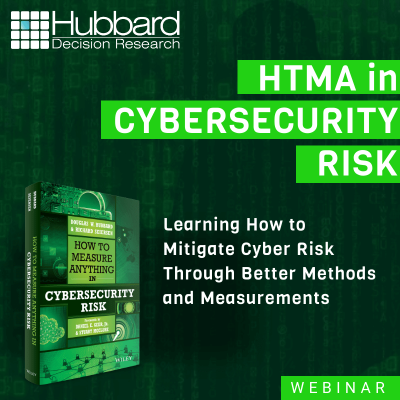Description
This series, with the 7 core courses delivered asynchronously, gives the participants hands-on training in the use of Applied Information Economics (AIE). AIE is a proven and powerful quantitative analysis method used by Fortune 500 companies, federal and state governments and the U.S. military to measure what matters and make objectively better decisions.
It consists of a total of 18 hours of training delivered in 7 courses. In this comprehensive training package, participants will learn how to apply quantitative analysis which measurably improves on expert judgement even in the most complex situations and with limited data. By the end of this training, there will be no “intangible” you can’t measure and you will completely rethink what and how you measure things to support the biggest decisions you make. The modules included are listed below.
Introduction to AIE Academy – Duration 15 minutes
This is a free session which provides an overview of training at HDR.
How to Measure Anything: Principles of Applied Information Economics – Duration: 2 hours
This is the first review of the methods used in Applied Information Economics (AIE). AIE is a decision-making method consisting of a collection of techniques that have each been shown to measurably improve estimates or decisions. This course is geared toward executives that need a conceptual understanding of the process without getting into the details of the quantitative methods involved. This overview covers the following components.
- What the research says about decision making: We will review how published research measured the performance of different methods and concluded that certain quantitative methods outperform them all.
- How to measure anything: We reveal how to overcome a key perceived obstacle to adopting these quantitative methods…the idea that some things just can’t be measured. We explain that the perception that something is immeasurable is always based on one or more of three misconceptions.
- Making a practical process: Finally, now that we have shown how quantitative methods can apply even where issues were previously thought to be immeasurable, we show how all the pieces come together. We show the steps in the AIE process, how it has been applied in many industries and surprising ways it changes your decisions..
How to Make Decisions Under Uncertainty – Duration: Approx. 2 hours
How can we make a decision when we are missing so much data and when nobody can predict the future exactly? In this course, we delve into the challenges and benefits of modeling decisions under uncertainty, how we can quantify risk tolerance and how we can compute the value of information can guide where and how we reduce uncertainty. We find that thinking through decisions this way will change what you measure and how quantifying risks will change your decisions.
Statistical Measurement Methods with Excel: Basic – Duration: 2 hours
This session shows you can perform statistical measurements with ready-made spreadsheet templates. You will learn how to think about measurements from a “Bayesian” perspective which allows you to use new data to update your current uncertainties. The spreadsheet tools will show how useful inferences can be made using random sampling even with just a little data. The methods covered will include using simple Bayesian methods to estimate the size, the mean, the median and proportions of a population even if you never get to see a tiny fraction of that population.
Statistical Measurement Methods: Intermediate – Duration: 2 hours
Prerequisite course: Statistical Measurement Methods: Basic
This session builds on the methods covered in the Basic version of this course. We cover how we can use controlled experiments and regression models to isolate a particular measurement even when there are lots of other factors affecting the measurement. We show how these methods can use publicly available data to improve forecasts about the economy, diseases and other topics.
Calibrated Probability Assessments – Duration: 3-4 hours
Prerequisite: None
Calibration is one of the most powerful and proven ways to improve decision-making. In this Calibration training, participants will learn how to assess subjective probabilities in a way that can be both measured and measurably improved. Each participant will see their ability to assess probabilities improve during a series of exercises where they are required to make estimates of uncertain quantities. Between exercises, they will learn additional techniques to continuously improve each estimate. By the end of the training, participants will see that their assigned probabilities reflect real uncertainty – that is, they are right 80% of the time they are 80% confident, 90% of the time they are 90% confident, and so on. This is a skill that will stick with those who learn it for a long time and will completely change how they think about estimations and probabilistic models.
Creating Simulations in Excel: Basic – Duration Approx. 2 hours
What’s the chance that a project will lose money or be cancelled? What’s the most likely return on investment for a given investment? How likely is a particular risk or set of risks to happen – and how severe could their impacts be?
Running simulations has been shown to measurably improve estimates in uncertain decisions, but how can you run a simulation without complicated software requiring advanced training? This course teaches participants how to build a powerful tool – a Monte Carlo simulation that calculates thousands of scenarios – using only Microsoft Excel, with no additional training or software required. Not even coding in Visual Basic for Excel, user-defined functions or new Excel add-ons are needed. We only need native Excel using features that are already installed. Participants will learn how to use a powerful Pseudo Random Number Generator (PRNG) developed by Doug Hubbard. This is a formula that fits in a single cell in Excel and can be used to generate thousands of random values in a way that fools many of the best statistical tests of randomness.
Creating Simulations in Excel: Intermediate – Duration Approx. 2 hours
Prerequisite course: Creating Simulations in Excel: Basic
Building on the methods covered in the Basic course, this course will cover more features of Excel’s what-if data tables for simulations and more probability distributions to cover more real-world types of situations. We will cover more ways to use the powerful HDR multi-dimensional PRNG and how they can be used to generate random time series. We will also show how we can use the same simulations for estimating the value of additional information.
Course Access: All 7 core courses are completed at academy.hubbardresearch.com. Within 24 hours of registration each participant will receive an email with the access information to complete the self-paced online training.
Instructor Access: Once in the asynchronous courses, you can post questions in the forum or ask an instructor directly via email.
Would you prefer a private webinar limited to participants from your own organization?
We offer private webinar sessions for an organization with special discounted group rates. Contact us for more information and to schedule your next training session.




